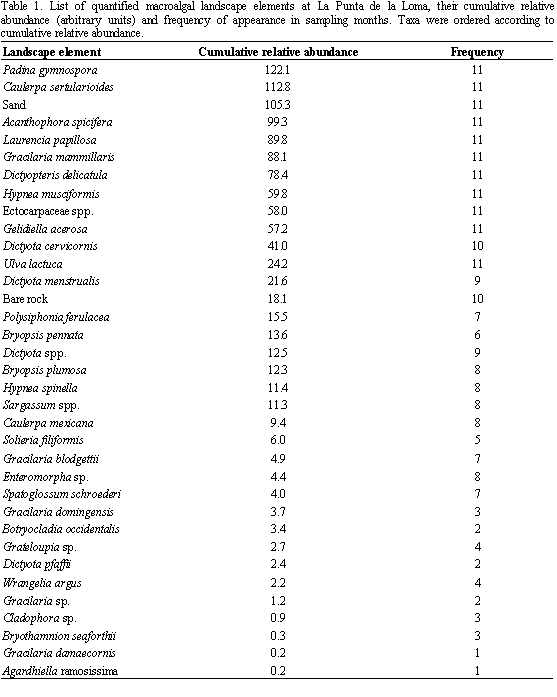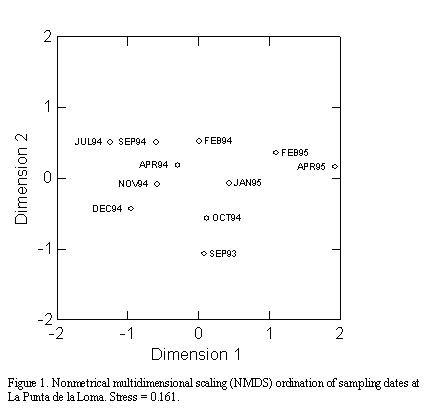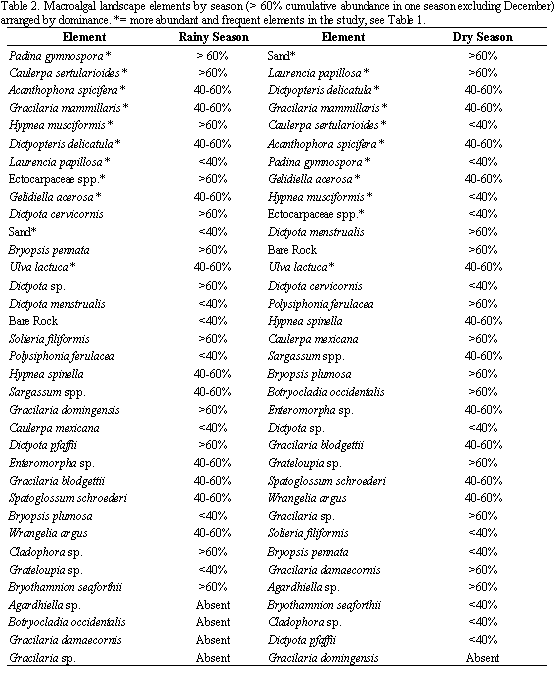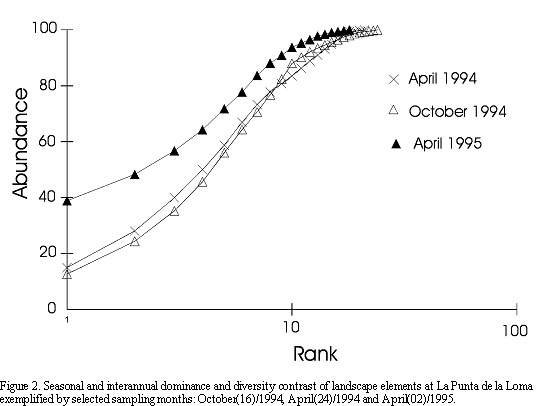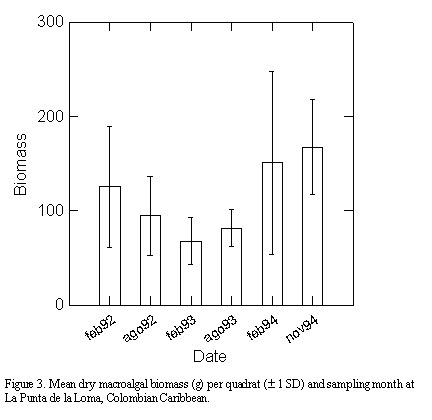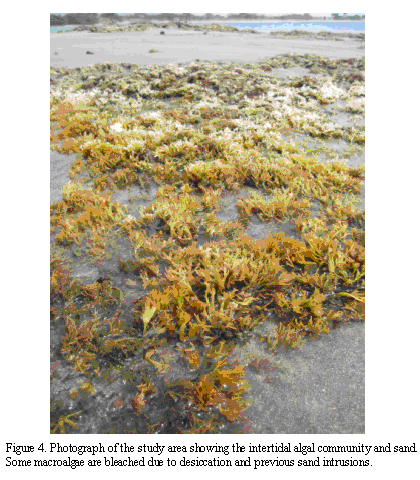Services on Demand
Journal
Article
Indicators
-
 Cited by SciELO
Cited by SciELO -
 Access statistics
Access statistics
Related links
-
 Cited by Google
Cited by Google -
 Similars in
SciELO
Similars in
SciELO -
 Similars in Google
Similars in Google
Share
Boletín de Investigaciones Marinas y Costeras - INVEMAR
Print version ISSN 0122-9761
Bol. Invest. Mar. Cost. vol.35 no.1 Santa Marta Jan./Dec. 2006
DYNAMICS OF A MACROALGAL ROCKY INTERTIDAL COMMUNITY IN THE COLOMBIAN CARIBBEAN
DINÁMICA DE UNA COMUNIDAD MACROALGAL DEL INTERMAREAL ROCOSO EN EL CARIBE COLOMBIANO
Camilo B. García1 and Guillermo Díaz-Pulido2
1Universidad Nacional de Colombia, Departamento de Biología, CECIMAR/INVEMAR, Cerro Punta Betín, Santa Marta, Colombia. E-mail: cgarcia@invemar.org.co and cbgarciar@unal.edu.co
2Universidad del Magdalena, Programa de Biología/INTROPIC, A.A. 1122, Santa Marta, Colombia. E-mail: guillermo.diaz@unimagdalena.edu.co
ABSTRACT
The macroalgal intertidal community at a tropical location (Punta de la Loma, Colombian Caribbean) was monitored at irregular intervals from 1992 to 1995. The highly diverse macroalgal community was relatively invariant in cover, taxa and biomass from small spatial scales (square centimeters). At larger spatial scales (square meters), however, there was a small but definitive seasonal pulse in dominance and composition. Sand intrusions over the rocky intertidal represents a b disturbance reducing macroalgal cover during the dry season. Interannual variation was also detected. La Punta de la Loma appears to be influenced by the regional upwelling conditions.
KEY WORDS: Dynamics, Macroalgal landscape, Intertidal, Colombian Caribbean.
RESUMEN
La comunidad macroalgal intermareal en una localidad tropical (La Punta de la Loma, Caribe colombiano), fue monitoreado a intervalos irregulares entre 1992 y 1995. La altamente diversa comunidad macroalgal presentó pocos cambios en cobertura, número de taxa y biomasa a la escala espacial de los cuadrantes (centímetros cuadrados). Sin embargo, a la escala espacial del paisaje (metros cuadrados) se detectó un pulso estacional en dominancia y composición, pequeño pero definido. Invasiones parciales de arena en la época seca constituyen fuertes eventos de perturbación que reducen la cobertura macroalgal. También se detecto variación interanual. La Punta de la Loma parece estar sujeta a las condiciones locales de surgencia.
PALABRAS CLAVE: Dinámica, Paisaje macroalgal, Intermareal, Caribe Colombiano.
INTRODUCTION
The Caribbean coast of Colombia has a variety of marine ecosystems and habitats, such as coral reefs, seagrass beds, mangroves, and rocky shores. Most rocky shore area is abrupt, with steep slopes. However, broader (>1-20m) rocky intertidal platforms occur at some sites, harboring rich and abundant macroalgal communities. The dynamics of such communities have received little attention in the region and consequently, there is little information on the diversity, distribution, and variability of these algal assemblages (Díaz-Pulido and Díaz-Ruiz, 2003).
It is widely known that intertidal communities display important changes in community structure at varying spatial and temporal scales. Temperate intertidal communities are highly seasonal and variable at different spatial scales (Underwood and Chapman, 1998; Underwood 2000). Ecological processes such as herbivory, disturbance, predation, and recruitment, as well as oceanographic conditions, have been shown to structure intertidal communities (reviewed in Menge and Branch, 2001). In the tropics, intertidal communities may also vary through time. However, the processes driving community dynamics are not well understood. Furthermore, it is not clear how algal communities vary at different spatial (cm2 - m2) and temporal scales (within and between years).
Studies on the dynamics of hard bottom communities in Colombia are rare. Most information available on macroalgal communities of the area has focused on spatial patterns of organization (Guillot and Márquez, 1978; Brattström, 1980; Márquez and Guillot, 1983; Díaz-Pulido and Díaz, 1997). Seasonal variations in algal communities in Colombia have been documented for coral reefs (Díaz-Pulido and Garzón-Ferreira, 2002) and rocky intertidals (García, 1992; Nuñez et al. 1999). However, changes at larger temporal scales (e.g. > 1 yr) have only been documented for upwelling coral reef communities (Rodriguez-Ramírez and Garzón-Ferreira, 2003) and there is no information about interannual dynamics of rocky intertidal communities. Our study is noteworthy in that algal communities were monitored over several years.
In this study we describe temporal changes in the intertidal community and non-living elements (sand and bare rock), at La Punta de la Loma, Santa Marta area, Colombian Caribbean, from 1992 to 1995.
STUDY SITE
La Punta de la Loma (11o07'31"N, 74o14'00"W, approximately) is an exposed rocky platform encrusted with fossil corals and lithified mangrove roots (von Erffa and Geister, 1976), surrounded by sandy beaches. The platform provides wide horizontal intertidal surface favoring the establishment of a diverse algal community. The intertidal community at this location is dominated by benthic macroalgae, including algal turfs, foliose and erect seaweeds, and crustose coralline algae. Invertebrates such as corals, anemones, and sponges are common. The study focused on the macroalgal assemblage. There are two main climatic and oceanographic seasons in the region: the dry season, from December to April, and the rainy season, from May to November (Salzwedell and Müller, 1983). During the dry season trade winds blow from the northeast reach their highest intensity, and generates upwelling. During the calmer, rainy season, temperature rises and salinity decreases due to cessation of the upwelling and to increase of continental discharges.
MATERIAL AND METHODS
To investigate the temporal dynamics of the intertidal community and abiotic elements, we used 0.25 m2 (50 x 50) PVC quadrats divided in 25 subquadrats. To determine macroalgal biomass variations (i.e., dry weight per species/quadrat), several randomly placed quadrats were denuded during February-March 1992 (8 quadrats), August 1992 (8 quadrats), February 1993 (8 quadrats), August 1993 (14 quadrats), February 1994 (4 quadrats) and November 1994 (4 quadrats).
The relative abundance of intertidal elements (species of macroalgae, sand and bare rock) was estimated by point sampling using the same quadrats (described above) in September 1993 (58 quadrats), February 1994 (93 quadrats), April 1994 (16 quadrats), July 1994 (16 quadrats), September 1994 (16 quadrats), October 1994 (16 quadrats), November 1994 (16 quadrats), December 1994 (16 quadrats), January 1995 (15 quadrats), February 1995 (16 quadrats) and April 1995 (16 quadrats). Quadrats were haphazardly placed on the rocky shore but not exact spot was revisited in subsequent sampling dates. The intersections of the subquadrats within each quadrat were used as points, giving a total of 16 points sampled points per quadrat. As more than one species per point could be recorded due to superposition of species, frequently total points recorded exceeded 16 for a given quadrat.
Because different number of quadrats were sampled at each time period, the abundance (number of points) of intertidal elements is expressed relative to sampling effort, i.e., relative to the total number of points recorded given a sampling date, and multiplied by 100 for easy numerical manipulations.
Temporal trends were explored by means of nonmetric multidimensional scaling ordination (NMDS, Field et al. 1982) performed on a Bray-Curtis dissimilarity matrix. The null hypothesis that intertidal configuration was the same in the rainy (May to December regardless of the year of sampling) and dry (January to April regardless of the year of sampling) seasons, was tested by means of the ANOSIM procedure (Clarke and Green, 1988). Patterns of diversity and dominance were explored over time by means of k-dominance curves (Lambshead et al., 1983). As partial sand intrusion events were an important disturbance feature during the study, they were correlated with historical mean values for cumulative monthly photoperiod, discharges of the Magdalena river, rainfall, and wind velocity using Pearson correlations.
A Kruskal-Wallis analysis of variance was carried out on species and abiotic elements present in all sampling dates, to test the null hypothesis that mean relative abundance between seasons was the same. December data was excluded to obtain equal number of sampling dates per season (five). Two-way analysis of variance was used to test the null hypothesis that mean (log) biomass per season was the same regardless of sampling year.
In order to assess macroalgal dynamics at the quadrat spatial scale (square centimeters, in contrast to landscape spatial scale, square meters, which includes sand and bare rock) one-way analysis of variance was used to test the null hypotheses that relative abundance and number of taxa per quadrat were the same between months and seasons. Quadrats in which sand or bare rock appeared were therefore excluded from this analysis.
RESULTS
We found 53 macroalgal taxa on the rocky intertidal platform during the study (see Appendix 1 with systematic list), although only 33 were found and quantified within the quadrats (Table 1). The most abundant and most frequent species included the brown algae Padina gymnospora, the green Caulerpa sertularioides and the reds Acantophora spicifera, Laurencia papillosa and Gracilaria mamillaris (Table 1). Mean taxa richness per month was nearly equal between seasons (22.3±2.5 S.D. in the rainy season and 21.2±3.9 S.D. in the dry season).
Ordination analysis (NMDS) showed that sampling dates from the dry season clustered separately from those of the rainy season, excepting April/1994 that appeared in the middle of the plot. Interannual variability was also indicated by the ordination position of sampling months sampled in different years (Figure 1). The null hypothesis that the configuration of landscape elements at La Punta de la Loma was similar for the dry and rainy seasons (ANOSIM procedure, p<0.05).
Recorded landscape elements (i.e, algal taxa, sand and bare rock) were sorted into three groups: elements predominantly present in the dry season or in the rainy season and elements with no preference. Preference was arbitrarily assigned when cumulative abundance of a given element accounted for more than 60% in one season (excluding December to obtain a balanced design of equal number of months (5) per season). The
groups formed are shown in Table 2. Approximately 1/3 of the elements were insensitive to seasonal change, whereas 1/3 were sensitive either to the dry or rainy seasons (Table 2). However, when Kruskal-Wallis one-way analysis of variance was used to test the null hypothesis of equal mean relative abundance per sampling month among seasons (excluding December again) for those elements that appeared in the 11 sampling dates,
only sand and Caulerpa sertularioides showed significant differences (p<0.05). This finding suggested irregular expansions and contractions of the landscape elements month after month, i.e., high relative abundance variability. Nevertheless there was a definitive dominance reordering from one season to the other (Table 2).
The macroalgal intertidal community was most diverse in October 1994, which historically has been the rainiest and calmest month of the year (see k-dominance curves, Figure 2). In contrast, in April 1995, which corresponds to the driest and windiest time of the year, the macroalgal landscape was less diverse (Figure 2). The pattern had exceptions though. For example, diversity in April 1994 could not be distinguished from diversity in October 1994.
Macroalgal biomass varied significantly throughout the years of study, being higher during 1994 following 1992 and 1993 (Figure 3). Two-way analysis of variance revealed no significant differences between seasons nor season and year (p>0.05), but a significant difference between years (p<0.05). Tukey multiple comparisons resulted that total macroalgal biomass was significantly different (p<0.05) among the three years.
Relative abundance of taxa per quadrat, i.e., at the quadrat spatial scale, was not different between seasons (p>0.05) but it was significantly different between months (p<0.05), with taxa in September 1993 significantly less densely packed than taxa in April1994 and October 1994 (p<0.05, Tukey post-hoc test). Taxa number per quadrat was not significantly different between months (p>0.05) but it was between seasons (p<0.05). However, this last difference was more a statistical artifact than a substantial difference in taxa number between seasons as the absolute difference in taxa number per quadrat is less than one: 7.124±0.438 (95%CI, n=89) in the rainy season versus 7.957±0.700 (95%CI, n=70) in the dry season.
Table 3 shows the correlation matrix between several environmental factors and sand cover. The bimodal nature of the local climate was evident in that wind velocity was inversely correlated to discharges of the Magdalena river and rain, whereas rain was positively correlated to discharges of the Magdalena river. As expected, sand cover was correlated with wind velocity, and inversely correlated with discharge from the Magdalena river. This result was reinforced the fact that sand+bare rock monthly mean cover was substantially lower in the rainy season (May to December, 4.0±2.3 S.D.) than in the dry season (January to April, 20.0±14.9 S.D.). Thus, sand intrusions were a disturbance clearly associated with the dry season (Figure 4).
DISCUSSION
One of the striking features of this intertidal community is the high species diversity of macroalgae. More than 55 macroalgal species co-occur in an area of ca 600 m2. Several hypotheses have been put forward to explain why so many species can co-exist at the same time and location, exploiting the same resources (competitive exclusion principle). Intermediate physical disturbance and herbivory have been suggested as factors promoting species diversity in rocky shores (Sousa 1984, 1985; Dean and Connell, 1987; Mengue and Branch, 2001). In this study we found that sand intrusions disturb the algal community on a regular basis, probably acting as an intermediate disturbance force promoting high diversity. Sand deposited over the macroalgal community is then washed out and rocky substrate becomes available again for algal colonization, thus avoiding dominance by few species.
Herbivore pressure has not been measured at La Punta de la Loma, but herbivorous fishes, urchins, and gastropods are common and are likely to exert some top-down control on algal dynamics. Other disturbance processes, such as desiccation and wave stress, may also contribute to high local species diversity. However, from our data we support the idea that the seasonal impact of sand deposition over the intertidal community in the dry season, is a likely main mechanism controlling species diversity. Sand intrusion has been identified as a bottom-up disturbance in other rocky littoral environments in the Colombian Caribbean (Nuñez et al., 1999), as it results in freeing (space) resources.
At the landscape scale taxa composition and relative dominance of biotic and abiotic elements (i.e. sand and bare rock), showed a small but definitive seasonal pulse (Figure 1). Clearly superimposed on the regular seasonal pulse, interannual differences also occur as shown in biomass and in the ordination map (Figure 1). At the quadrat scale the macroalgal community was highly variable as to overshadow seasonal differences (for those quadrats placed in the area where sand intrusions never reached), confirming findings by García (1992) for number of genera and biomass. In contrast, at the landscape scale relative dominance of landscape elements, i.e. including sand and bare rock (with consequences on absolute cover of the algal bed), showed a small but definitive seasonal pulse and interannual variability.
The floristic composition related to the coastal upwelling (Bula-Meyer, 1977 and 1985) on the northern coast of the Colombian Caribbean was not expressed at La Punta de la Loma. Bula-Meyer (1985) excludes La Punta de la Loma coast line from the upwelling influence, arguing a peculiar wind regime and the influence of warm brackish water from the neighboring Ciénaga Grande de Santa Marta (Bula-Meyer, 1985, p. 13), a large coastal lagoon. Indeed no temperate or subtropical species (e.g. Porphyra) were present in the algal assemblage, and in terms of composition the marine flora from La Punta de la Loma was similar to other rocky intertidal shores in the Caribbean (Díaz-Pulido and Bula-Meyer, 1997).
The seasonal pattern of species diversity observed in La Punta de la Loma was different to that of the adjacent area of the Tayrona National Natural Park (TNNP). Macroalgal communities were more diverse in the rainy season (e.g. October) than in the dry, upwelling season (e.g. April) at the study site, while at the TNNP macroalgal communities from coral reefs (Díaz-Pulido and Garzón Ferreira 2002), sand plains (Bula-Meyer, 2001) and sea grass beds (Rangel, 2005), are more diverse during the dry, upwelling season. This illustrates the large variability in the dynamics of algal communities in the Colombian Caribbean region.
The seasonal variability (depending on the spatial scale of observation, the landscape or the quadrat) modified by interannual changes demonstrated that if we are to understand intertidal community dynamics, several spatial and temporal scales need to be considered.
ACKNOWLEDGEMENTS
Many thanks to the botany students (1992-1993) of the Universidad de Bogotá Jorge Tadeo Lozano, Santa Marta, for collecting part of the material, and to Iovana Moreno and Claudia Arango who helped in the field.
LITERATURE CITED
1. Brattström, H. 1980. Rocky-shore zonation in the Santa Marta area, Colombia. Sarsia, 65: 163-226. [ Links ]
2. Bula-Meyer, G. 1977. Algas marinas bénticas indicadoras de un área afectada por aguas de surgencia frente a la costa Caribe de Colombia. An. Inst. Invest. Mar. - Punta de Betín, 9: 45-71. [ Links ]
3. Bula-Meyer, G. 1985. Un núcleo nuevo de surgencia en el Caribe Colombiano detectado en correlación con las macroalgas. Bol. Ecotropica, 12: 3-25. [ Links ]
4. Bula-Meyer, G. 2001. Ecología de las macroalgas del plano arenoso contiguo al talud de los sistemas coralinos con énfasis en el Caribe. Rev. Ac. Col. Cien. Exac., Fís. y Nat., 25:495-507. [ Links ]
5. Clarke, K.R. and R.H. Green. 1988. Statistical design and analysis of "biological effects" study. Mar. Ecol. Prog. Ser., 92: 213-226. [ Links ]
6. Dean, R.L. and J. Connell. 1987. Marine invertebrates in an algal succession. II. Test of hypothesis to explain changes in diversity with succession. J. Exp. Mar. Biol. Ecol., 109: 217-247. [ Links ]
7. Díaz-Pulido, G. and G. Bula-Meyer. 1997. Marine algae from oceanic atolls in the Southwestern Caribbean (Albuquerque Cays, Courtown Cays, Serrana Bank, and Roncador Bank). Atoll Res. Bull.,448: 1-18. [ Links ]
8. Díaz-Pulido, G. and J.M. Díaz. 1997. Algal assemblages in lagoonal reefs of Caribbean oceanic atolls. Proceedings of the Eighth International Coral Reef Symposium, Panama; 1827-1832. [ Links ]
9. Díaz-Pulido, G. and J. Garzón-Ferreira. 2002. Seasonality in algal assemblages on upwelling-influenced coral reefs in the Colombian Caribbean. Bot. Mar., 45: 284-292. [ Links ]
10. Díaz-Pulido, G. and M. Díaz-Ruiz. 2003. Diversity of benthic marine algae of the Colombian Atlantic. Biota Colombiana, 4:203-246. [ Links ]
11. Erffa, A. von and J. Geister. 1976. Über ein holozänes Korallen- und Mangrovenvorkommen nahe Santa Marta, Kolumbien. Mitt. Inst. Colombo-Alemán Invest. Cient,. 8: 165-186. [ Links ]
12. Fajardo, G.E. 1979. Surgencia costera en las proximidades de la Península de la Guajira. Bol. Cient. CIOH, 2: 7-19. [ Links ]
13. Field, J.G, K.R.Clarke, and R.M. Warwick. 1982. A practical strategy for analysing multispecies distribution patterns. Mar. Ecol. Prog. Ser., 8: 37-52. [ Links ]
14. García, C.B. 1992. Estacionalidad de una comunidad algal intermareal en la region de Santa Marta, Caribe Colombiano: primeros resultados. In: Memorias VIII Seminario Nacional de Ciencias y Tecnologías del Mar, Santa Marta, Octubre 1992, CCO-Colciencias. pp. 601-605. [ Links ]
15. Guillot, G. and G. Márquez. 1978. Estudios en la vegetación béntica marina del Parque Nacional Natural Tayrona, costa Caribe Colombiana, I: relaciones vegetación-zonación-sustrato. An. Inst. Inv. Mar. - Punta de Betín, 10: 133-148. [ Links ]
16. Lambshead, P.J., H.M. Platt and K.M. Shaw. 1983. The detection of differences among assemblages of marine benthic species based on an assessment of dominance and diversity. J. Nat. Hist., 17: 859-874. [ Links ]
17. Márquez, G. and G. Guillot. 1983. La vegetación marina del Parque Nacional Tayrona, costa Caribe Colombiana, II: tipos de vegetación. An. Inst. Inv. Mar. - Punta de Betín, 13: 17-51. [ Links ]
18. Menge, B. A., and G. M. Branch. 2001. Rocky intertidal communities: 221-252. In: M. D. Bertness, S. D. Gaines and M. E. Hay (Eds.). Marine community ecology. Sinauer Associates, Sunderland, Massachusetts. [ Links ]
19. Núñez, S.G., N.H. López, C.B. García and G.R. Navas. 1999. Caracterización y comportamiento bimensual de la comunidad sésil asociada con el litoral rocoso de Bocachica, Isla Tierra Bomba, Caribe Colombiano. Cienc. Mar.,25(4): 629-646. [ Links ]
20. Rangel, A. 2005. Efectos de la herbivoría en el crecimiento del pasto marino Thalassia testudinum en el Parque Nacional Natural Tayrona. Santa Marta: Tesis de Grado, Programa de Biología, Universidad del Magdalena. [ Links ]
21. Salzwedell, H. and K. Müller. 1983. A summary of meteorological and hydrological data from the Bay of Santa Marta, Colombian Caribbean. An. Inst. Invest. Mar. - Punta de Betín, 13: 67-83. [ Links ]
22. Sousa, W.P. 1984. The role of disturbance in natural communities. Ann. Rep. Ecol. Syst., 15: 353-391. [ Links ]
23. Sousa, W.P. 1985. Disturbance and patch dynamics on rocky intertidal shores: 101-124 In: S.T.A Pickett and P.S. White (Eds.). The ecology of natural disturbance and patch dynamics. Academic Press. [ Links ]
24. Underwood, A. J. 2000. Experimental ecology of rocky intertidal habitats: what are we learning? J. Exp. Mar. Biol. Ecoll., 250:51-76. [ Links ]
25. Underwood, A. J. and M. G. Chapman. 1998. Variation in algal assemblages on wave-exposed rocky shores in New South Wales. Mar. Freshw. Res., 49:241-254. [ Links ]
DATE RECEIVED: 16/03/05 DATE ACCEPTED: 19/12/05













